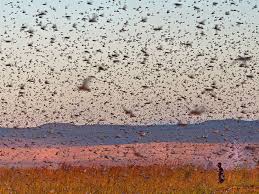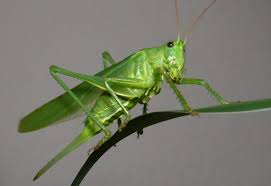If you have walked through a paddock on a warm summer’s day, chances are you will have encountered grasshoppers. If you have been camping and laid awake listening to the sounds of the night, you are probably familiar with the chirping of crickets.

They are both of the order Orthoptera which means “straight wings”, but they also have characteristically powerful hind legs for jumping. They can propel themselves twenty times their own body length with each jump. Insects of the order Orthoptera are also good singers. Males of the species attract females by producing sounds with their legs or wings, by rubbing them together to produce a vibration.
What is the difference between grasshoppers and crickets? Grasshoppers have short horns and feed during the day while crickets with their longer horn feed at night.
Grasshoppers and locusts are one and the same but they conjure up vastly different images. Grasshoppers are seen as interesting insects that children try to catch in grassy paddocks while locusts are seen as swarms of insects that destroy crops.

Although grasshoppers cause billions of dollars in damage to food crops annually, they provide an important source of protein to people in many parts of the world. People have eaten grass hoppers and locust for centuries. John the Baptist ate locusts and wild honey. In many areas of Africa, Asia and the Americas, they are a regular ingredient of the local diet.
The grasshopper benefits humans and the ecosystem in general by facilitating plant decomposition and regrowth, creating a balance between the types of plants that thrive. Despite their small size, grasshoppers consume enough plant life to influence the types of plants that subsequently grow. In fact depending on their “mood” they will eat different types of plants producing different types of fertilizer that may inhibit the growth of one type of plant while promoting the growth of another. What types of events could trigger the grasshoppers “mood” to make him produce a type of fertilizer to promote the growth of nitrogen rich plants and inhibit the growth of carbohydrate rich pants. More research needs to be done on this but could it be the presence of other insects, spider, weather patterns, the presence or absence of grazing herbivores? Is there an innate intelligence that we don’t yet understand that grasshoppers and other insects possess that tells them which plants will be more beneficial to the soil?
Just like any other insect or animal, grasshoppers excrete waste after eating. That waste is highly beneficial for fertilizing the soil and facilitating plant growth. Think of it this way: in a field of a half-dozen cows, the bovines create large piles of manure that microbes slowly break down to fertilize the soil (slow release fertilizer). In that same field, however, hundreds of grasshoppers are also producing excrement, and in much smaller amounts. The reduced size of the waste allows microbes to break it down more efficiently, fertilizing the soil faster.
While the grasshopper may not appreciate this particular role that he plays in the ecosystem, he is also a vital source of food for predators in the wild. And a ready source of food for many people.

